SP-4223 "Before This Decade Is Out..."
[284]
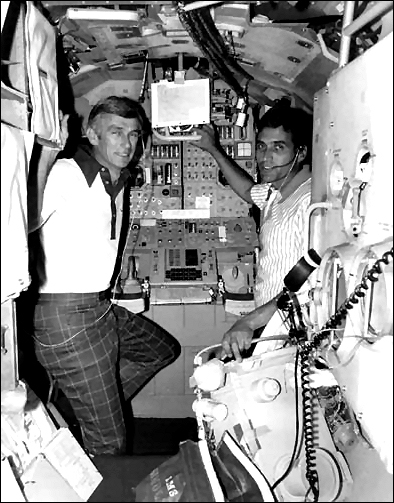
[285] Born July 3, 1935, in Santa Rita, New Mexico, Harrison Hagan "Jack" Schmitt became the first and only geologist to land on the Moon when he served as lunar module pilot of Apollo 17, the last Apollo lunar landing.
Growing up in Silver City, New Mexico, Schmitt was exposed to the sciences, particularly geology, at an early age while assisting his father, a mining geologist, during weekends in the field. While attending the California Institute of Technology, Schmitt was intent on becoming a physicist but soon found that he made a much better geologist and switched majors. After graduating from Cal Tech in 1957, Schmitt went on to obtain a PhD in Geology from Harvard University in 1964.
After finishing a postdoctoral fellowship in 1964, Schmitt joined the recently established Astrogeology branch founded by Eugene Shoemaker at the United States Geological Survey (USGS), in Flagstaff, Arizona. Schmitt helped develop techniques for field geology on the Moon and was named project chief for lunar fields geological methods. Soon after, NASA announced that they were seeking applicants for scientists-astronauts and Schmitt promptly applied.
NASA's announcement for applicants for this new group of astronauts came after considerable pressure from within the scientific community who pushed to have a trained scientist crew member onboard [286] one of the Apollo lunar landing missions. The National Academy of Sciences acted as a screening board, sending their recommendations from those applicants received to NASA. From the 1,000 applicants, 16 names were sent to NASA, including Schmitt's and two others from the USGS astrogeology branch. Schmitt was rejected along with the two other USGS applicants. Shoemaker was shocked by this and personally intervened on Schmitt's behalf to help get him selected. When NASA announced the six new scientist-astronauts to the public in June 1965, Schmitt's name was among them.
Schmitt immersed himself in his work, having no life outside of the Apollo program. One of Schmitt's first assignments after earning his pilot's wings and completing basic astronaut training was in working on the Apollo Lunar Science Experiments Package (ALSEP). He soon became the bridge between the astronaut corps and the scientific community, earning the respect of both. He worked successfully to educate his astronaut colleagues in the area of lunar geology, beginning with the crew of Apollo 8. In the summer of 1969, Schmitt helped recruit Lee Silver, a well-know field geologist and geochemical analyst, to help in training the astronauts in lunar surface field geology.
Schmitt also pressed for a chance to fly on his own mission for he knew that as a geologist, he had an edge over the other scientist-astronauts. In addition to knowing the science, Schmitt also had to master the many other technical aspects of a mission so he applied himself to the simulators, getting in as many hours on the different equipment as possible. His hard work eventually paid off as he was assigned to be the lunar module pilot for Apollo 17, displacing Joe Engle on the last lunar landing mission.
Schmitt, Commander Eugene Cernan, and Command Module Pilot Ronald Evans were launched in the early morning of December 7, 1972, the fiery climb of their Saturn V lighting up the Florida coastline for hundreds of miles around. After reaching lunar orbit three days later, Schmitt and Cernan left Evans in the command module "America" and boarded the lunar module "Challenger" to descend to the Sea of Serenity near the crater Littrow and the surrounding Taurus Mountains.
In July 1973, following Apollo 17, Schmitt was named a Sherman Fairchild Distinguished Scholar at Cal Tech, an appointment that ran until July 1975. From February 1974, Schmitt served as chief of the [287] scientist-astronauts within the Astronaut Office in the Flight Crew Operations Directorate at the Johnson Space Center. In May 1974, he became the assistant administrator of the Office of Energy Programs at NASA Headquarters.
After retiring from NASA in 1976, Schmitt went on to pursue a career in politics. That same year, he ran for and was elected to the U.S. Senate for the State of New Mexico. After an unsuccessful 1982 bid for reelection, Schmitt became an independent consultant for science, technology, and public policy.
[288] Editor's Note: The following is an edited transcription from a presentation given by Harrison Schmitt as part of an Apollo 11 20th anniversary celebration speakers series held during the week of July 17-21, 1989, at the Johnson Space Center in Houston, Texas. This presentation entitled "The Moon Before Apollo" was given on July 17, 1989, followed by a question and answer period from the audience.
The Earth is the basis of the knowledge with which we began our specialized and detailed studies of the Moon. Geology and Earth Sciences, in general, form the basis of those analyses through, not only decades before Apollo, but literally, centuries. We had a little bit of information about the Moon from this perspective as we began. Science may have been the least of the reasons most of the nearly 500,000 Americans signed up for Apollo. However, along with technology, national confidence, and human spirit, science benefited permanently from our exploits. Remembering just how little we knew about the Moon before Apollo serves to emphasize both how far we have come and how far we now may go. The Apollo program gave us a first-order understanding of the sequence of events and processes by which the Moon became what existed three billion years ago, and what remained until Armstrong, Collins, Aldrin, and myself arrived. However, this conclusion relates not only to events and processes after the Moon's formation near the Earth 4.6 billion years ago. I am one of the few remaining skeptics concerning the "Mars-size asteroid collision with the Earth" theory. The Moon's planetological tail, like that of my golden retriever, Pecos, wags on much fact but also on much uncertainty. The fact we have seen and measured; the resolution of uncertainty, we must leave to the future.
The first known facts about the Moon were accessible even to our distant ancestors as they planned monthly hunting and gathering around ancient African lakes. Had they looked closely at the full Moon, as they may well have done, and I'm sure did, they would've seen very light regions interrupted in some places by sharply defined circular, or nearly circular, areas. These circular areas and other more irregular regions would have been seen to be very dark, relative to the light regions. If our great ancestors had good eyes and squinted, they would have seen even then, several very bright spots on both the light and dark regions.
[289]
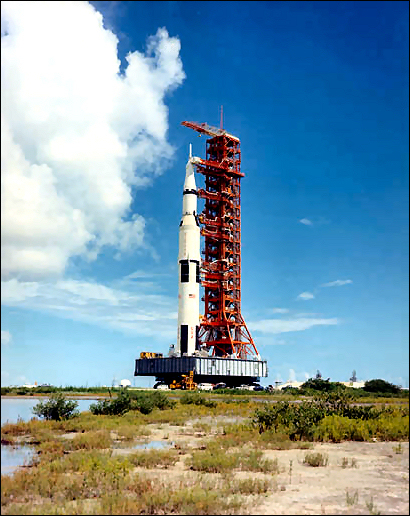
In the 16th century, the observations and logic of Copernicus, following in the footsteps of Aristarchus and probably others before him who remain unrecorded, demonstrated that the Moon orbited the Earth while both bodies orbited the Sun. Then, in the 17th century, Galileo invented the telescope. Through this remarkable [290] example of human ingenuity and technology, it was soon discovered that the very light areas were cratered terra, or highlands; the dark areas were less heavily cratered basins, or lowlands-at first mistaken for seas and called maria-and the bright spots were craters with vast systems of bright radial patterns, or rays. Kepler, Newton, and others, also in the 17th century, provided the mathematical means of calculating the Moon's shape, roughly a sphere; size, a radius of about 1,738 km; a mean density of about 3.34 g/cm3; and a moment of inertia, about .400 for the principal moment. These facts, although slightly inaccurate, place limits on the composition-that is, the overall Moon was similar to stony meteorites that fall on the Earth and had significantly less iron rela-tive to the Earth and the Sun. They also placed limits on the distribution of mass within the Moon. With any logical bent, these same observers must have realized that the Moon had no clouds or other apparent protection from the ravages of space and the Sun, although I'm not aware of that observation being recorded.
Gilbert's studies of lunar surface features in the 19th century began modern geological considerations of the Moon. During the mid-20th century, Yuri, Keifer, and Baldwin contributed new insights from indirect analysis on composition, age, shape, motions, and surface properties. In the years just preceding human footsteps on the Moon's surface, and as it became apparent that humans might soon go there, knowledge of this small planet's past expanded rapidly through specialized investigations. Schumacher, Hackman, and many others used telescopic observations, photographs from space probes, and the extension of Steno's law of superposition to add refinements to the more ancient text about the Moon. That law of superposition, by the way, merely states that things that are on top are usually younger. There are, I'm sure, exceptions to that. The highlands appeared saturated with large meteor-impact craters, at least 50 km in diameter, and were clearly the oldest visible crust of the Moon. The analyses by the last Surveyor spacecraft demonstrated that this light-colored crust contained significant calcium and aluminum. The large, circular basins not only cut through the upper crust, but through large, irregular basins as well. Evidence existed for previously unrecognized [291] materials that formed light-colored plains in old basins and lowlands. Early in this modern, but still remote, study, it became clear that the dark maria were vast plains of remarkably fluid volcanic flows, visually similar to the rock basalt common here on Earth. Both Ranger photographs and Surveyor analyses confirmed these conclusions. These flows filled the large circular and irregular basins on the Moon's front side and covered some of the light plains as well.
The Lunar Orbiter photography showed that the back side of the Moon had only local areas of dark maria to interrupt an almost continuous expanse of cratered highlands. Tracking of Lunar Orbiter and, later, the Apollo 8 and 10 missions, disclosed the unexpected presence of mass concentrations [mascons] in the large circular basins, indicating great structural strength-at least at present. It soon became clear that little major activity had occurred on the Moon's surface after the last mare flow had cooled, estimated from crater frequency assumptions as having occurred a few hundred million years ago. This estimate was only off by a factor of 5 or 6.
As new studies became more detailed, an overprint of subtle features became apparent. The surfaces of the maria and highlands had been altered at some later, but as yet undetermined, time. A lengthy ridge and volcanic island system splits the Moon's largest western mare basin, Procoleram; strange, sinuous rills and light-colored swirls locally interrupt the surface of many areas; and extensive, relatively young, extensional fault systems-that is, pull-apart fault systems, in particular what we called "robins" -cut large regions of the surface. These fault systems showed that the outer crust of the Moon could not support significant shear stress, even though it could support the extensive mass concentrations. Overall, a pulverized rock layer, or soil, or regolith covered essentially all the surface, attesting to continuous bombardment from space and radiation from the Sun. Before any pieces of rocks or scoops of soil arrived from the Moon, we knew that the following sequence of events had occurred once the Moon had reached roughly its present size: An old, highly impacted crust-rich silicate crust-rich in calcium and aluminum, had formed. Second,....
[292]
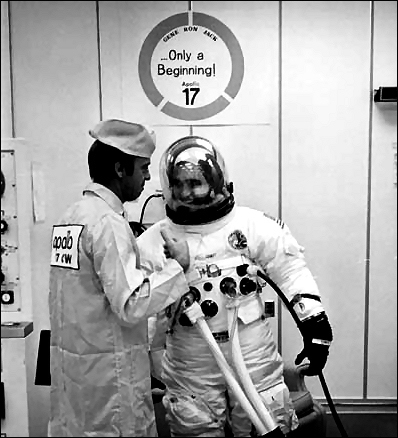
....large irregular, and, later, circular basins were created in this old crust by very large, almost inconceivably large, impact events. The floors of many basins were covered, in part, by light-colored, smooth plains of unknown origins. Most of the basins were filled to unknown depths by basaltic lava flows. After all major changes such as those I've mentioned had ceased, the surface was slightly modified by the formation of constructional volcanic deposits-[293] faults, rills, and light-colored swirls. And finally, pulverized rock soil, or regolith, formed in response to meteor and radiation bombardment from space and the Sun.
What we did not know were the how and when of the Moon's formation and evolution. Scientists still struggle with the "how" of the formation of the Moon. We may still be barking up the wrong tree on that one, or, as we say on the Moon, "wheezing up the wrong crater." However, I cannot resist this opportunity to summarize the evolutionary sequence I find supports the data of which I am aware at the conclusion of the Apollo explorations. The major lunar evolutionary stages and their defining characteristics appear to be as follows.
First, the beginning-clearly about 4.6 billion years ago in which we had the formation of the Moon roughly contemporaneously with the formation of the Earth. The process of formation cannot have produced a fully molten or partially molten Moon because subsequent differentiation would have eliminated both, one, the relative undifferentiated material rich in volatiles and primordial lead required as a deep-source material for the orange and green soils, about which many of you have heard; and, second, the density reversal at 200 km or 300 km depth required to maintain the present average density of the Moon-two, as I see it, very important constraints on any model of formation. This suggests a beginning through accretion of relatively cold material rather than through catastrophic separation of a preexisting and largely differentiated Earth.
Secondly, we had the melted shell. Now we have somewhat more agreement that, between 4.6 and 4.5 billion years ago, accretionary melting, or residual heat from formation, and volatile depletion of the outer 200 km to 300 km of the Moon, so-called magma ocean, with accompanying differentiation into a 60 km to 70 km thick anorthocitic crust and a 200 km to 300 km thick mafic, or iron- and magnesium-rich upper mantle. It is likely that, prior to the development of a coherent crust, large accretionary impacts mixed undifferentiated melt into the protocrust, or early crust, adding both an overall gabbroic contaminant (that is, a magnesium- and iron-rich contaminant) and many splash intrusions of [294] significant size represented by the so-called INT suite of lunar samples. The residual liquid in this differentiating melted shell gradually took on the chemical characteristics attributed to an original type of rock that we've never really seen called "URKREEP." KREEP, as you may recall, was the acronym applied to potassium, rare Earth element, and phosphorus rich samples that reached prominence mainly in Apollo 14. The original material from which KREEP was evolved has taken on the name "URKREEP." Due to the concentration of radioisotopes, it probably remained a liquid, radioisotopic heat maintaining it as such. During the accretion and melting of this shell, emissible iron sulphur liquid settled to its base and ultimately migrated downward to form a still fluidized core of about 500 km radius. These processes of differentiation, however, did not significantly affect the composition of relatively undifferentiated lower mantle material.
The third phase, the cratered highlands: 4.5 to about 4.3 billion years ago, saturation of the lunar crust, formed and preserved impact structures, 50 km to 100 km in diameter, and created a remarkable time in lunar history as well as, almost certainly, in Earth history. Significant regional homogenization of the upper crust and intense brecciation of the lower crust to at least 25 km depth took place at this time. The insulating properties of the brecciated and pulverized (that is, intensely broken) upper crust allowed the gradual accumulation of radioisotopic heat necessary to eventually partially remelt the mantle and produce the basaltic maria.
The fourth phase, the old large basins and crustal-strengthening phase: about 4.3 to around 4.0 billion years ago, there was the formation of what are called pre-nectarian large basins (that's just a generalized code for the age) with rapid isotopic adjustment of the crust. This was permitted by both the URKREEP-the original KREEP liquid-underlying the crust and the pervasive fracturing in that crust. After the first, now somewhat irregular, large basins formed over much of the Moon's surface, the relatively low density URKREEP liquid moved upward into the deeply and closely fractured crust. KREEP model ages of 4.4 to 4.3 billion years may indicate the time of the initiation of this movement. Moving upward into the cooler upper crust and becoming significantly [295] contaminated with crustal debris in the process, the KREEP-related liquid ultimately crystallized and formed interlocking networks of intrusions. KREEP-basalt crystallization ages of 4.2 to 3.9 billion years indicate the timing of the solidification of these intrusions. Once solidified, these interlocking intrusions-and I think you can imagine what that would be like in a broken crust like the Moon's-these interlocking intrusions combined with the removal of the underlying destabilizing URKREEP liquid, strengthened the crust, which had to happen. KREEP-related magmas contaminated with anorthocitic crustal materials may have reached the floors of the deepest early basins. Later, redistribution of materials from near-surface KREEP basalts, by impacts, may help to account for the observed age spectrum of the KREEP basalt samples we have found throughout the regolith.
The fifth phase, the young large basins: in a brief period, probably about 4.0 to 3.9 billion years ago, there was the formation of what are known as nectarian and embriem age large, circular impact basins in a crust strong enough now to support mass concentrations and, indeed, mass deficiencies indefinitely, until we began to observe them in this century. Crustal penetration of the embriem event was deep enough to eject significant volumes of KREEP-related intrusive material around its basin (where we now see it).
The sixth phase, the light colored plains: this is a very controversial area and has been for many decades among those who have studied the Moon; but it does appear, both from Earth-based and satellite-based mapping and from visual observation of the surface by myself and a few others, that about 3.9 or 3.8 billion years ago, lunar-wide debris was deposited in most of the then existing basins and may have resulted from a combination of the final degassing of the mantle that preceded the formation of the basalt maria (magmas), something that one would expect to happen, with crustal debris entrained as the gasses moved upward and the wide-scale redeposition of fine debris ejected during large basin formation. Many of the observed surface expressions of the so-called light-colored plains, or calix formation, and the nature of the samples from the Descartes landing site, appear to be explained by this mode of origin.
[296] The seventh period, the basaltic maria (the man-in-the-Moon phase): from 3.8 to 3.0, and maybe more, billion years ago, there was surface eruption and subsurface intrusion of basaltic maria, probably appearing first at a salinographic low in the vicinity of northern Tranquilitatus and southern Serenitatus with subsequent eruptions appearing in very roughly concentric zones around this low. Rare Earth element geochemistry suggests that progressively deeper zones of the lunar mantle melted to give rise to the age sequence and, of course, chemical sequence that we see in the mare basalt magmas. Pyroclastic eruptions (that is, fire-fountain type eruptions) of basaltic material-such as the orange and green soils-containing volatile components and primordial lead derived from below the original melted shell accompanied late-stage mare eruptions in many, if not most, regions.
The eighth and final phase of lunar evolution, the changing crust: from 3 billion years ago to the present, there have been a number of changes to this crust, none of them extremely obvious but still changes that we now know about. The formation of the Procolarem volcanic ridge system and the eastern limb and western far side light-colored swirls are most important, and they are possibly due to a brief period-a very brief period -of mantle convection which, because of the Moon's size, was turned off quite quickly. The present lunar regolith formed during this period in response to a continuous, but gradually declining, meteor impact frequency.
Apollo 11 began the process of understanding the evolution of the Moon and, indeed, the early evolution of the Earth. From the Moon, we gained information about the early history of the Earth that would have been impossible to gain from the Earth itself. Through this remarkable effort on the part of national leaders, managers, engineers, workers, industry, a worldwide community of scientists, and the American people and their families, and through the other Apollo and lunar missions, we now have looked with new insight at our own planet and other terrestrial planets. Because of this, investigations reached towards real understanding of the early differentiation of the planets, the nature of their internal structure, the environmental dynamics during the origin of life-one of the more exciting aspects of it-the influence of very large impact....
[297]
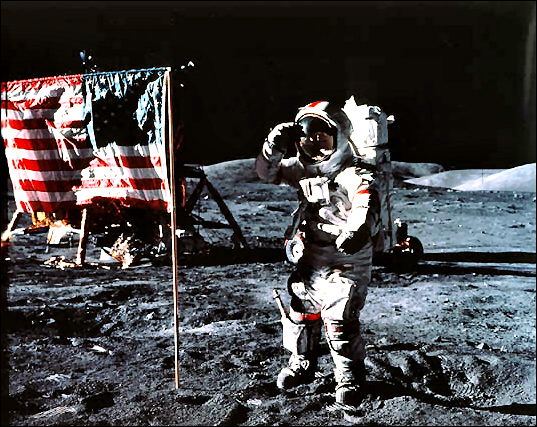
....events, and the effects of early partial melting of protomantles, or early mantles, of the planets, and possibly the earliest manifestations of plate techtonics. The Apollo explorations were of incalculable value in adding the reality of known materials and processes to the interpretation of data from subsequent automated explorations of the solar systems-something we also, I think, tend to forget.
What would we have known about Mercury and Mars and Venus and other terrestrial-type planets without the detailed understanding we achieved about the Moon? Now, it has been recently noted that, early in the third millennium, the Moon's mare regolith may provide vast and environmentally benign energy resources required by Earth and the consumables required for martian settlement. This prospect of the next great human challenge and the next great human adventure being tied together by the resources of.....
[298]
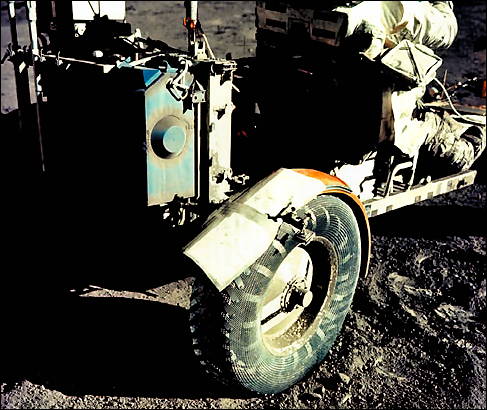
....the Moon, I think is extraordinarily exciting. Not too bad for a program born of international competition, but made more than that by the early and expansive insights of those who designed and operated the systems necessary to win that competition. Science and humanity owe these giants more than will ever be repaid.
What potential does the Moon have as an energy source for use here on Earth and as a source of materials to assist us in the further exploration and settlement of space?
[299] I think there is a lot of interest in that and more, probably, is deserved-principally because the greatest danger that this thin shell of an atmosphere or biosphere (the Earth) has in the foreseeable future probably comes from the continued consumption of fossil fuels. And so, some alternative in the not too distant future to fossil fuels for both the generation of electricity and portable fuel that we use in transportation is essential. We must look not only here on Earth but elsewhere for such alternatives. Looking at the Moon for such an alternative, we see basically three possibilities, two of which are closely related. One is to utilize solar energy, either collected on the Moon itself, utilizing lunar materials for the collectors, or in solar satellites, utilizing lunar materials for the collectors and beaming that energy back to Earth in a network of power beaming and distribution to be utilized essentially anywhere that it's needed on Earth. There are, as you might imagine, tremendous complexities with that idea. But the cost of doing that and the relative return on any investment that might be made is not clear and won't be for some time, but it certainly deserves some study.
The other alternative, which I personally find even more exciting, is that we have found in the Apollo 11 samples the presence of trace amounts of an isotope of helium called Helium 3-10 to 20 parts per billion of this particular isotope of helium. Helium 3 is a potential fuel when combined with dueterium (an isotope of hydrogen) in fusion reactors. You probably have heard of other fuels for fusion reactions-dueterium can be a fuel as well as tridium, which is the current most extensively researched fuel for fusion reactors-but tridium and dueterium have the difficulty of producing very long-lived radioactivity in their reactors. Tridium has some short-lived radioactivity, of course; but the problem is that, when you burn them in reactors, you get a lot of high-energy neutrons and they, in turn, create radioactive contamination within the reactors themselves, and, indeed, actually damage the reactors. Whereas, with Helium 3, the principal product of fusion is a proton, and a proton is relatively benign with respect to creating radioactivity. There are some side reactions that produce some neutrons, but they're not in major amounts, as it now appears from the calculations. Not only are protons attractive from the point of [300] view of ultimate radioactive waste, but they're attractive in that they represent a way of directly converting energy to electricity. So, the efficiency of Helium 3 fusion reactors may well be as much as twice that of other types of reactors. Now, you may ask, "But, 10 or 20 parts per billion in the lunar soil? How in the world does that make any sense as a terrestrial energy source?" Well, let me give you a couple of numbers to put that into perspective. A metric ton of Helium 3 contains as much energy as two billion dollars worth of coal burned today as a source of electricity. Two billion dollars worth of coal will provide the electricity (in this country) for
10 million people for about a year. As an old economic geologist, when I hear about a resource that may be worth two billion dollars a metric ton, I can start to think of all sorts of ways that I might get access to that resource. It doesn't mean we've figured it out yet, but I think it does serve to illustrate why the establishment of a lunar base in the perspective of protecting our global environment starts to make an awful lot of sense as a national investment in the future. And, you get a tremendous payoff in addition, because the next great human adventure will be the settlement of Mars, and in the process of refining and processing lunar soils for Helium 3, you create vast tonnages of other gaseous elements: hydrogen, water, carbon compounds, and nitrogen compounds in particular. Those are exactly what one needs to initiate and catalyze the settlement not only of the Moon but of Mars. So, the Moon acts as a bridge between the great challenge we face here on Earth and the great adventure we have ahead of us in the solar system.
Looking back, how valuable were the unmanned precursors to the Moon such as Ranger and Surveyor, to the manned Apollo missions?
In advance of Apollo, given the state of our knowledge and the state of consensus about the surface of the Moon in several respects, Ranger and Surveyor were of tremendous importance. Just as an anecdote: My mother, who is 85, still remembers more vividly seeing Ranger pictures on television with "Live from the Moon" printed out at their base than, I think, she does the Apollo 17 [301] mission to the Moon. Someone born in 1904 seeing something on television in the first place has an interesting perspective, but seeing a picture that, believably, is live from the Moon has an even greater perspective. And, I wouldn't be surprised if she's not alone, that the first clear pictures that were coming from the Moon, just prior to the impact of the Ranger vehicles, did a lot to lay a psychological base within this country for us to go on and do other things. In addition, having done my first exercise in lunar traverse planning on a Ranger 8 photograph, I think it taught us a great deal about the complexities of doing geology on the Moon in that, the closer you got to the Moon, the more difficult it was to decide what are we were going to do to maximize the efficiency of our exploration activities? At least it taught me that lesson, and, with being deeply involved in the traverse planning later on, I think it was an important experience for me.
There was a more political question than I think a geological question about the nature of the surface. There was, I think, a geological consensus that astronauts would not be swallowed up by dust on the surface. There was a misinterpretation of some radar data by Dr. Tommy Gould that he parlayed into a great deal of excitement and expense for NASA in suggesting that there was a thick layer of dust on the Moon. The Surveyor spacecraft, of course, by landing, totally disproved that, and that should've been no longer a concern. It didn't quiet Tommy very much, but it should've been of no great concern. In addition, Surveyor began to outline the broad chemical parameters that we were going to deal with in our analysis of the lunar samples. And even though a great deal, if not most, of the groundwork for the analysis of the lunar samples had already been laid-internationally, by the way-and it's important to remember that the analysis of lunar materials was really the first major international science program in space. We often forget that science had internationalized space long before Apollo-Soyuz did. Nevertheless, Surveyor began to alert these people to the kinds of systems they were going to be dealing with: in the highlands-silicate systems dominated by calcium and aluminum-and in the mare-silicate systems dominated by magnesium and iron. And that, again, I think was an important....
[302]
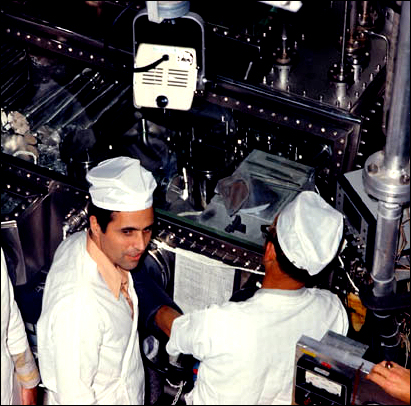
[303] ....criteria. And Surveyor, of course, also added to the psychological confidence that we could do it. Even though the first few didn't make it, the latter ones did, and we showed that, operationally, working precisely in deep space was something we could do, and Lunar Orbiter continued that tradition. That's one of the reasons, as an aside, why I say, "I think we're ready to go to Mars now, because we've learned all those lessons." Indeed, we probably have more information about the surface of Mars, its properties, and what we need to do to work in the vicinity of Mars, through its atmosphere, and on its surface, now, today, than we had even before Apollo 11 landed on the Moon.
Precursors are nice; they will provide and can provide a great deal of interesting scientific information but, from an operational point of view, I am not one of those that thinks we should hang our hat on the success of precursors before we begin that process of extensive exploration and ultimate settlement of Mars.
What were the main criteria used in the selection of the Apollo lunar landing sites?
Every landing site was selected, in part, to give us a different look at the lunar materials, and that included their composition. I guess one would say there were two major criteria in the selection of landing sites. One was the desire to sample as broad a range of rock and chemical types of lunar materials as we could, and, secondly, to look at as broad a range of processes, of structural features, geographic features, if you will, as we possibly could. And, indeed, the sharpest contrasts would have existed compositionally, in reference to your question, between those landings on the lunar maria-the dark parts of the Moon, the mare basalt areas-the highlands, such as in Descartes at the Appenine front, in the south and north massifs of later missions; and, of course, the landing at the Apollo 14 site, known as Frau Mauro, where we ran into this material I referred to earlier as KREEP. So, there were three major contrasting compositional regions sampled, and within even the individual mare sites, there were very, very great differences. For example, the Apollo 11 and 17 sites exposed us to very titanium-rich basalts; [304] whereas, the Apollo 12 and Apollo 15 sites were significantly lower in that element. That's interesting in regard to Helium 3, because it turns out that Helium 3 tends to be concentrated in the higher titanium soils. Helium 3 comes from the Sun, along with these other gaseous elements, and is absorbed in the lunar soils from the solar wind. But even at a given site, and I looked probably most closely at the Apollo 12 sites, you get contrasts. Some flows will be titanium poor, some flows titanium rich, and so the heterogeneity of both lunar composition and lunar processes is very great.